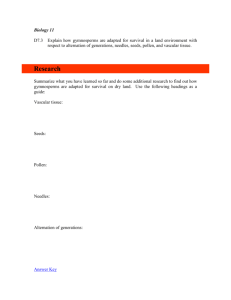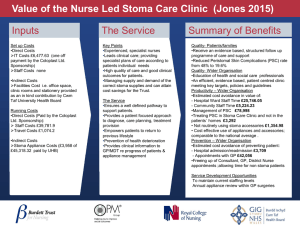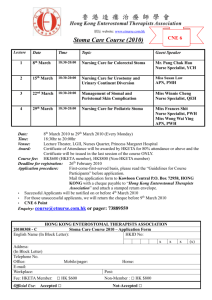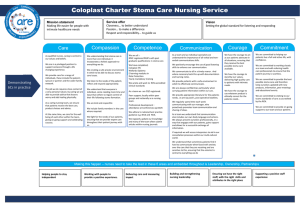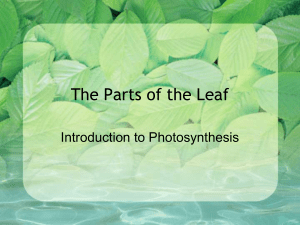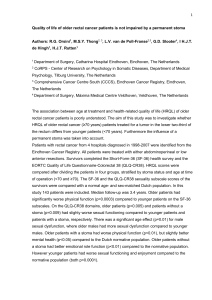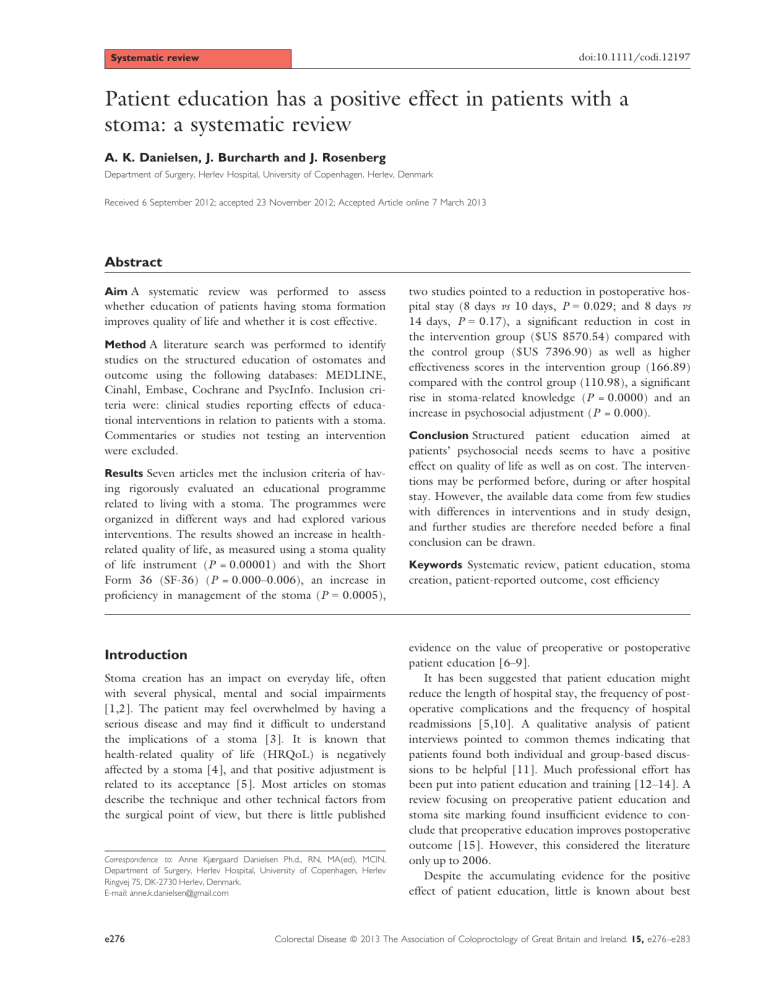
doi:10.1111/codi.12197 Systematic review Patient education has a positive effect in patients with a stoma: a systematic review A. K. Danielsen, J. Burcharth and J. Rosenberg Department of Surgery, Herlev Hospital, University of Copenhagen, Herlev, Denmark Received 6 September 2012; accepted 23 November 2012; Accepted Article online 7 March 2013 Abstract Aim A systematic review was performed to assess whether education of patients having stoma formation improves quality of life and whether it is cost effective. Method A literature search was performed to identify studies on the structured education of ostomates and outcome using the following databases: MEDLINE, Cinahl, Embase, Cochrane and PsycInfo. Inclusion criteria were: clinical studies reporting effects of educational interventions in relation to patients with a stoma. Commentaries or studies not testing an intervention were excluded. Results Seven articles met the inclusion criteria of having rigorously evaluated an educational programme related to living with a stoma. The programmes were organized in different ways and had explored various interventions. The results showed an increase in healthrelated quality of life, as measured using a stoma quality of life instrument (P = 0.00001) and with the Short Form 36 (SF-36) (P = 0.000–0.006), an increase in proficiency in management of the stoma (P = 0.0005), Introduction Stoma creation has an impact on everyday life, often with several physical, mental and social impairments [1,2]. The patient may feel overwhelmed by having a serious disease and may find it difficult to understand the implications of a stoma [3]. It is known that health-related quality of life (HRQoL) is negatively affected by a stoma [4], and that positive adjustment is related to its acceptance [5]. Most articles on stomas describe the technique and other technical factors from the surgical point of view, but there is little published Correspondence to: Anne Kjærgaard Danielsen Ph.d., RN, MA(ed), MClN, Department of Surgery, Herlev Hospital, University of Copenhagen, Herlev Ringvej 75, DK-2730 Herlev, Denmark. E-mail: anne.k.danielsen@gmail.com e276 two studies pointed to a reduction in postoperative hospital stay (8 days vs 10 days, P = 0.029; and 8 days vs 14 days, P = 0.17), a significant reduction in cost in the intervention group ($US 8570.54) compared with the control group ($US 7396.90) as well as higher effectiveness scores in the intervention group (166.89) compared with the control group (110.98), a significant rise in stoma-related knowledge (P = 0.0000) and an increase in psychosocial adjustment (P = 0.000). Conclusion Structured patient education aimed at patients’ psychosocial needs seems to have a positive effect on quality of life as well as on cost. The interventions may be performed before, during or after hospital stay. However, the available data come from few studies with differences in interventions and in study design, and further studies are therefore needed before a final conclusion can be drawn. Keywords Systematic review, patient education, stoma creation, patient-reported outcome, cost efficiency evidence on the value of preoperative or postoperative patient education [6–9]. It has been suggested that patient education might reduce the length of hospital stay, the frequency of postoperative complications and the frequency of hospital readmissions [5,10]. A qualitative analysis of patient interviews pointed to common themes indicating that patients found both individual and group-based discussions to be helpful [11]. Much professional effort has been put into patient education and training [12–14]. A review focusing on preoperative patient education and stoma site marking found insufficient evidence to conclude that preoperative education improves postoperative outcome [15]. However, this considered the literature only up to 2006. Despite the accumulating evidence for the positive effect of patient education, little is known about best Colorectal Disease ª 2013 The Association of Coloproctology of Great Britain and Ireland. 15, e276–e283 A. K. Danielsen et al. practice in the education of patients with a stoma. For this reason we performed a systematic review of the literature regarding education in patients having a stoma formation. Positive effects of education in patients with stoma discharge [23,24]; time until proficiency in managing the stoma [23]; readmissions [24]; and scores related to symptoms of depression, knowledge about the stoma, self-efficacy and psychosocial adjustment [25,26] (Table 1). Method Statistical analysis Study design A systematic review including both qualitative and quantitative studies was performed. We applied a method of joint synthesis based on narrative summaries of all included studies on a study level [16]. The literature was searched from 1950 to July 2012 using MEDLINE, Cinahl, Embase, Cochrane and PsycInfo databases, with the following MESH search terms: patient education and ostomy. Related search terms in all fields were: ileostomy, ileostomies, colostomy, colostomies, stoma*, ostomy, effect, efficiency, impact. Search terms were combined with the Boolean operators AND and OR to identify relevant studies. We applied a filter to include studies in English, German and Danish, and only retrieved papers that were accessible as full-text. Furthermore, we searched the references to supply the systematic search [17]. Study selection criteria The searches were carried out by the first author, and the first and second authors then discussed them. To identify the most fitting inclusion and exclusion criteria, we used the pico-question for quantitative studies [18]: P(opulation): patients, admitted for stoma creation; I (ntervention): teaching sessions; C(omparison): before/ after stoma creation; and O(utcome). Following removal of duplicate reports, we excluded papers based on title and abstract (Fig. 1). Then, eligible articles were reviewed independently by two reviewers, and consensus was obtained through discussion. Only studies that evaluated patient educational activities incorporating stoma creation were included. Descriptive reports were excluded. The studies were analysed separately, and as they did not have comparable outcomes or interventions it was not possible for us to carry out any statistical synthesis of the effects [27]. The results were presented as narrative summaries of the outcomes of the included studies. However, we present all the statistical results that were reported in the individual studies. Results Forty-five papers were identified, of which 38 were excluded (Fig. 1) (14 were duplicates, four were not retrievable, eight did not focus on the correct theme and 12 were rejected because they were descriptive papers or commentaries). Seven studies (Table 1) met the inclusion criteria of having rigorously evaluated an educational programme related to stoma creation (Table 2). Only quantitative studies were included in the review, as the literature search did not retrieve any articles reporting studies with a qualitative design. Health-related quality of life HRQoL was assessed in two single-group interventional studies [20,21]. The first study included 50 patients, who participated in six sessions with a total of 16 h of teaching over a time period of 6 weeks [21]. Patients were assessed three times, and the results showed a positive and statistically significant difference between the first and the third assessments (P = 0.0001). The second study included 72 patients who participated in all-day education sessions performed every 4–6 months. The results revealed a statistically significant improvement in HRQol in those having education. Data extraction Data extraction from relevant studies was performed by two reviewers, and data quality was scored by both reviewers according to PRISMA guidelines [19]. PRISMA stands for Preferred Reporting Items for Systematic Reviews and Meta-Analyses. It is an evidence-based minimum set of items for reporting in systematic reviews and meta-analyses. The outcomes were presented as health-related quality of life (HRQoL) [20,21]; cost effectiveness [22]; days until postoperative Assessment of self-care knowledge, self-care attitude, self-care behaviour, self-efficacy, self-management and psychosocial adjustment Self-care knowledge was explored in two studies [25,26]. The first study, a randomized controlled trial (RCT), assessed self-care knowledge, self-care attitude and self-care behaviour relating to life after stoma creation and included 102 participants (46 in the experimental group and 56 in the control group) enrolled Colorectal Disease ª 2013 The Association of Coloproctology of Great Britain and Ireland. 15, e276–e283 e277 A. K. Danielsen et al. Identification Positive effects of education in patients with stoma Records identified through database searching (n = 44) Additional records identified through other sources (n = 1) Screening Records after duplicates removed (n = 31) Records screened (n = 31) Records excluded : not the right focus (n = 8) Eligibility Records not retrievable (n = 4) Full-text articles assessed for eligibility (n = 19) Included Full-text articles excluded: no clinical intervention: (n = 12) Studies included in review (n = 7) Figure 1 Flow diagram of the study design [21]. shortly after stoma creation whilst still in hospital [25]. The assessment of knowledge was performed at baseline and 1 week after discharge. The questionnaires were based on Likert or binominal scales, and showed a significant difference between groups in scores related to self-care knowledge (P < 0.001), self-care attitudes (P < 0.001) and self-care behaviour (P < 0.001). The second study, a single-group interventional study, exploring the effect of patient education performed by expert patients (patients with a stoma who were trained to become expert patient-teachers as part of the study) assessed knowledge related to stoma care, e278 self-efficacy, self-management and psychosocial adjustment [26]. Ninety-two participants were included, whereof 11 were trained as expert patients. The assessment of the stoma-related knowledge showed a significant increase in six domains of knowledge (P = 0.001), and self-efficacy and self-management (P = 0.001). Time until discharge and proficiency in stoma management A single-group study explored the influence of preoperative patient education on time to discharge after stoma Colorectal Disease ª 2013 The Association of Coloproctology of Great Britain and Ireland. 15, e276–e283 A. K. Danielsen et al. Positive effects of education in patients with stoma Table 1 Outcome of included studies. Study Design/population Results Olsen, 2011 [21] Descriptive study. Examining effect of patient education within 2 years after stoma creation. Patients with a stoma as a result of benign disease were primarily included. Median age 59 years HRQoL measured at baseline, and after module 5 and module 6. A significant difference was found between measurements (P < 0.0001) Chaudhri et al., 2005 [23] RCT studying the effects of intensive community-based preoperative stoma education compared with current practice of postoperative stoma education and an economic assessment. Forty-two patients (21 in each group) underwent stoma creation. Median age = 64 (range, 36–82) years Proficiency in management of the stoma was obtained after 5.5 (range, 2–10) days in the study group compared with 9 (range, 4–10) days in the control group (P = 0.0005). Postoperative hospital stay was 8 days for the study group compared with 10 days for the control group (P = 0.029). Fewer unplanned visits post discharge was seen in the intervention group Lo et al., 2011 [25] Single-blinded RCT to test the effectiveness of a multimedia education programme. One hundred and two patients with a stoma were randomized, with 46 people placed in the intervention group and 56 in the control group The self-care knowledge scale, the self-care attitudes scale and the self-care behaviour scale revealed statistically significant differences in the experimental group as well as in the control group Lo et al., 2010 [22] RCT evaluating whether multimedia learning programmes were more or less cost effective than conventional education service programmes. The participants were 54 patients after stoma creation (27 subjects in each group) The cost-effectiveness analysis was measured including stoma care knowledge, attitudes and behaviours, and found a reduction in costs between the intervention group ($US 7396.90) and the control group ($US 8570.54) Cheng et al., 2012 [26] Precourse postcourse single-group comparison to study the short-term effects of an EPP. Ninety-two eligible patients with stomas (up to 3 years after stoma creation) volunteered to participate, whereof 11 were trained to be expert patients and the remaining 81 participated in the 3-week EPP course The total level of stoma-related knowledge increased significantly in the 66 tested domains. The total score for stoma care self-efficacy increased significantly, but the domain of social life and other items did not improve. The total score for stoma self-management increased. All three domains of psychosocial adjustment increased Younis et al., 2011 [24] Comparison of retrospective data before introduction of the ERP compared with prospective data from patients enrolled in the ERP. The aim of the study was to explore the length of hospital stay. One hundred and twenty patients undergoing elective anterior resection were compared with 120 patients adhering to an ERP Baseline data did not differ. Average length of hospital stay was 14 (range, 7–25) days before introduction of the ERP. This was reduced to 8 (range, 3–17) days in the patients following the ERP (P = 0.17). Hospital discharge was postponed in 21 patients because of a delay in independent stoma management via the ERP, compared with only one patient experiencing such a delay after the introduction of the ERP Colorectal Disease ª 2013 The Association of Coloproctology of Great Britain and Ireland. 15, e276–e283 e279 A. K. Danielsen et al. Positive effects of education in patients with stoma Table 1 (Continued). Study Design/population Results Altuntas et al., 2012 [20] Precourse postcourse single-group intervention study to evaluate the effects of patient education on HRQoL. Seventy-two patients were enrolled after creation of ileostomy, colostomy or urostomy. The median period between surgery and education was 7 (range, 1–75) months There was a statistically significant improvement in all eight profile scores except for the vitality score EPP, expert patient programme; ERP, enhanced recovery programme; HRQoL, health-related quality of life; RCT, randomized clinical trial. creation [24]. The results pointed at a significant reduction in the average length of hospital stay after introduction of the enhanced recovery programme. The readmission rates for the control and the experimental groups were 2.5% and 0%, respectively, and no patient was readmitted for stoma-related issues. An RCT [23] explored the effect of preoperative training in the homes of the patients, which was aimed at reducing postoperative hospital stay. Forty-two patients (21 in each group) were included, all undergoing elective colorectal resection with formation of a temporary or a permanent stoma. Postoperative assessment of stoma proficiency was performed by the ward nursing staff using a specific checklist. The median duration of hospital stay was 8 (range, 5–15) days for the study group and 10 (range, 4–16) days for the control group (P = 0.029). Following discharge there were fewer unplanned readmissions in the study group than in the control group, although this was not statistically significant. Furthermore, the time until proficiency in the management of the stoma was 5.5 (range, 2–10) days in the study group compared with 9 (range, 4–10) days in the control group (P = 0.005). Cost-effectiveness analysis An RCT assessed the cost effectiveness of patient education when using a multimedia educational programme compared with a conventional education service programme [22]. Fifty-four patients admitted to the surgical ward for any kind of stoma formation, were included and randomized. The cost-effectiveness analysis was based on measurements of self-care knowledge, self-care attitude and self-care behaviour that were related to calculation of the direct costs tied to the provision of healthcare. The cost-effectiveness calculation showed that patients in the intervention group received a more effective and less costly intervention, pointing at e280 a reduction in costs in the experimental group ($US 7396.90) compared with the control group ($US 8570.54). Discussion Although few studies are available, this review supports that patient education may have a positive effect on HRQoL, on length of stay after stoma creation, on level of knowledge and self-efficacy, and on cost effectiveness. In two of the included studies, participants admitted for patient education had had a stoma for a median of 5.5 months [21] and 7 months [20], respectively. These are relatively long periods of time, and in both studies some of the participants had had their stoma for 2 years or longer. Therefore, it should be considered that an increase in HRQoL may simply occur with time following stoma creation [4]. However, in this study it was not possible to identify the unique scores of patients with a stoma of the gastrointestinal tract. The curriculum of the different patient-education programmes focused on issues that are generally recognized to be important to patients after stoma creation, such as handling the stoma, different kinds of appliance, nutrition and sexuality [5,28–30]. In addition, the educational activities were organized in groups, which enabled participants to share their experiences and to learn from each other. This may be central as stoma creation can lead to feelings of stigma [31] and self-imposed isolation [32]. Organizing teaching sessions with lay teachers is not common. When introducing lay teachers to people with chronic disease, a significant improvement regarding self-efficacy and health status was shown [33]. However, to date, the issue of introducing lay teachers or peer teachers in patient education aimed at patients with a recently created stoma has not been fully explored. Colorectal Disease ª 2013 The Association of Coloproctology of Great Britain and Ireland. 15, e276–e283 ✓ Youinisk et al., 2011 [26] ✓ ✓ ✓ ✓ ✓ ✓ ✓ Altunas et al., 2012 [22] ✓ Chaudhri et al. 2005 [25] Olsen, 2011 [23] CN, colorectal specialist nurse. Lay teacher: teachers who have a stoma themselves. ✓ ✓ Lo et al., 2011 [27] ✓ ✓ ✓ Lo et al., 2010 [24] ✓ ✓ Cheng et al., 2012 [28] ✓ ✓ ✓ ✓ ✓ ✓ ✓ ✓ ✓ ✓ ✓ ✓ ✓ ✓ of stoma bag stomas sexuality and drink by the researcher stoma care admission admission admission Study ✓ as teachers teachers stoma model including emptying ✓ based sessions professionals self-training about stoma care, for patients with social impact, daily activities, food answers’ session showing hospital hospital hospital ✓ Group- Individual Health- Lay Hand out of by CN teaching self-management life, work-life, complications, ‘Questions and DVD After including: family care, stoma-related During Formal education including: stoma Before sessions Positive effects of education in patients with stoma Handbook about Table 2 Interventions applied in the included studies. Formal education Home visits A. K. Danielsen et al. The cost-effectiveness results from the included study [22] demonstrated a positive outcome in relation to cost effectiveness. Nevertheless, it should be questioned whether the measurement instrument was sufficiently sensitive to detect real differences between the baseline assessment and a second assessment only 1 week later. Moreover, a cost-efficiency ratio should preferably be assessed after a long study period, as there is some evidence that the beneficial effects may last for only a short period of time [34]. More studies on the cost effectiveness of patient education are obviously needed. The length of hospital stay was explored in two studies [23,24]. In the first, description of the assessment of proficiency in stoma management was stated and was closely related to the time of discharge [23]. Furthermore, interventions applied before admission to hospital were reported, and the results indicated a shorter time to discharge. The second study [24], exploring the effect of patient education, did not specify how patients’ competence was assessed. Moreover, the risk of selection bias should be discussed as the patients in the control group had open surgery, whereas those in the intervention group had laparoscopic surgery. Self-care knowledge, self-care-attitude, self-care behaviour, self-efficacy, self-management and psychosocial adjustment [22,25,26] were separately assessed in three studies. Although these reported several interesting outcomes, it might not be justified to assume that such a gain in knowledge would automatically imply a change in behaviour and the ability to use the knowledge [35]. Nevertheless, the published data are favourable for patients participating in educational activities. The limitations of this systematic review lie primarily in the heterogeneity and scarcity of data published on patient education and stoma creation. When reviewing the literature, we initially intended to perform the search for studies reporting different methodologies [36,37]. Unfortunately, however, no studies using qualitative research methodology were found. Moreover, some of the included studies lacked rigour and did not clearly report the interventions and the outcome measurement scales. Therefore, it was not possible to perform any kind of statistical synthesis, as the studies varied in design, method and outcome measures. Despite these difficulties, the results indicated a positive impact of patient education on patients’ psychosocial needs, self-care knowledge, attitude and behaviour. They also suggested that education may be cost effective. Sessions by a specialist in the patient’s home before surgery may reduce the length of hospital stay, although, as this conclusion is based on only a few studies with large differences in interventions and Colorectal Disease ª 2013 The Association of Coloproctology of Great Britain and Ireland. 15, e276–e283 e281 Positive effects of education in patients with stoma design, the effect of patient education in patients with a newly created stoma should be further evaluated. Conflicts of interest The authors report no conflicts of interest. Author contributions Study conception and design: AKD, JB, JR; acquisition of data: AKD; analysis and interpretation of data: AKD, JB; writing and reviewing manuscript: AKD, JB, JR. Funding The study was initiated by the authors and was not externally funded. References 1 Sprangers MA, Taal BG, Aaronson NK, te Velde A. Quality of life in colorectal cancer. Stoma vs. nonstoma patients. Dis Colon Rectum 1995; 38: 361–9. 2 Brown H, Randle J. Living with a stoma: a review of the literature. J Clin Nurs 2005; 14: 74–81. 3 Carlsson E, Berndtsson I, Hallen A-M, Lindholm E, Persson E. Concerns and quality of life before surgery and during the recovery period in patients with rectal cancer and an ostomy. J Wound Ostomy Continence Nurs 2010; 37: 654–61. 4 Hamashima C. Long-term quality of life of postoperative rectal cancer patients. J Gastroenterol Hepatol 2002; 17: 571–6. 5 Simmons KL, Smith JA, Bobb K-A, Liles LLM. Adjustment to colostomy: stoma acceptance, stoma care self-efficacy and interpersonal relationships. J Adv Nurs 2007; 60: 627–35. 6 Jeter KF. Perioperative teaching and counseling. Cancer 1992; 70: 1346–9. 7 Erwin-Toth P. Ostomy pearls: a concise guide to stoma siting, pouching systems, patient education and more. Adv Skin Wound Care 2003; 16: 146–52. 8 Turnbull GB, Erwin-Toth P. Ostomy care: foundation for teaching and practice. Ostomy Wound Manage 1999; 45: 23–30. 9 Metcalf C. Stoma care: empowering patients through teaching practical skills. Br J Nurs 1999; 8: 593–603. 10 Beaver K, Latif S, Williamson S et al. An exploratory study of the follow-up care needs of patients treated for colorectal cancer. J Clin Nurs 2010; 19: 3291–300. 11 Grant M, Ferrell B, Dean G, Uman G, Chu D, Krouse R. Revision and psychometric testing of the City of Hope Quality of Life-Ostomy Questionnaire. Qual Life Res 2004; 13: 1445–57. 12 Burch J. Providing information and advice on diet to stoma patients. Br J Community Nurs 2011; 16: 479–84. e282 A. K. Danielsen et al. 13 O’Shea HS. Teaching the adult ostomy patient. J Wound Ostomy Continence Nurs 2001; 28: 47–54. 14 Benjamin H. Teaching the stoma care routine to a patient with a low vision. Br J Nurs 2002; 11: 1270–7. 15 Colwell JC, Gray M. Does preoperative teaching and stoma site marking affect surgical outcomes in patients undergoing ostomy surgery? J Wound Ostomy Continence Nurs 2007; 34: 492–6. 16 Goldsmith MR, Bankhead CR, Austoker J. Synthesising quantitative and qualitative research in evidence-based patient information. J Epidemiol Community Health 2007; 61: 262–70. 17 Greenhalgh T, Peacock R. Effectiveness and efficiency of search methods in systematic reviews of complex evidence: audit of primary sources. BMJ 2005; 331: 1064–5. 18 Moher D, Liberati A, Tetzlaff J, Altman DG. Preferred reporting items for systematic reviews and meta-analyses: the PRISMA statement. Int J Surg 2010; 8: 336–41. 19 Liberati A, Altman DG, Tetzlaff J et al. The PRISMA statement for reporting systematic reviews and meta-analyses of studies that evaluate health care interventions: explanation and elaboration. J Clin Epidemiol 2009; 62: 1–34. 20 Altuntas YE, Kement M, Gezen C et al. The role of group education on quality of life in patients with a stoma. Eur J Cancer Care 2012; 21: 776–81. 21 Olsen AG. Stoma education provides a new life [Stomiskole giver nyt liv]. Sygeplejersken 2011; 21: 78–81. 22 Lo S-F, Wang Y-T, Wu L-Y, Hsu M-Y, Chang S-C, Hayter M. A cost-effectiveness analysis of a multimedia learning education program for stoma patients. J Clin Nurs 2010; 19: 1844–54. 23 Chaudhri S, Brown L, Hassan I, Horgan AF. Preoperative intensive, community-based vs. traditional stoma education: a randomized, controlled trial. Dis Colon Rectum 2005; 48: 504–9. 24 Younis J, Salerno G, Fanto D, Hadjupavlou M, Chellar D, Trickett JP. Focused preoperative patient stoma education, prior to ileostomy formation after anterior resection, contributes to a reduction in delayed discharge within the enhanced recovery programme. Int J Colorectal Dis 2012; 27: 43–47. 25 Lo S-F, Wang Y-T, Wu L-Y, Hsu M-Y, Chang S-C, Hayter M. Multimedia education programme for patients with a stoma: effectiveness evaluation. J Adv Nurs 2011; 67: 68–76. 26 Cheng F, Xu Q, Dai XD, Yang LL. Evaluation of the expert patient program in a Chinese population with permanent colostomy. Cancer Nurs 2012; 35: 27–33. 27 Higgins J, Green S. (2008) Cochrane Handbook for Systematic Reviews of Interventions Version 5.0.1. The Cochrane Collaboration, 2011. 28 Haugen V, Bliss DZ, Savik K. Perioperative factors that affect long-term adjustment to an incontinent ostomy. J Wound Ostomy Continence Nurs 2006; 33: 525–35. 29 Herlufsen P, Olsen AG, Carlsen B, Nybaek H, Jemec GBE, Karlsmark T. The causes of peristomal skin disorders. Colorectal Disease ª 2013 The Association of Coloproctology of Great Britain and Ireland. 15, e276–e283 A. K. Danielsen et al. 30 31 32 33 J Wound Ostomy Continence Nurs 2007; 34(Supplement): 73. Persson E, Gustavsson B, Hellstr€ om A-L, Lappas G, Hulten L. Ostomy patients’ perceptions of quality of care. J Adv Nurs 2005; 49: 51–8. MacDonald LD, Anderson HR. Stigma in patients with rectal cancer: a community study. J Epidemiol Community Health 1984; 38: 284–90. Danielsen AK, Burcharth K, Soerensen EE, Rosenberg J. Learning to live with a permanent intestinal ostomy: impact on everyday life and educational needs. J Wound Ostomy Continence Nurs 2013; [in press]. Foster G, Taylor SJC, Eldridge SE, Ramsay J, Griffiths CJ. Self-management education programmes by lay leaders for Positive effects of education in patients with stoma 34 35 36 37 people with chronic conditions. Cochrane Database Syst Rev 2007; CD005108. Riemsma RP, Taal E, Kirwan JR, Rasker JJ. Patient education programmes for adults with rheumatoid arthritis. BMJ 2002; 325: 558–9. Rankinen S, Salanter€a S, Heikkinen K et al. Expectations and received knowledge by surgical patients. Int J Qual Health Care 2007; 19: 1–13. Dixon-Woods M, Agarwal S, Jones D, Young B, Sutton A. Synthesising qualitative and quantitative evidence: a review of possiblemethods. J Health Serv Res Policy 2005; 10: 45–53. Greenhalgh T. Integrating qualitative research into evidence based practice. Endocrinol Metab Clin North Am 2002; 31: 583–601. Colorectal Disease ª 2013 The Association of Coloproctology of Great Britain and Ireland. 15, e276–e283 e283
